NerdCraft Nation: The Combat of #KingdomHearts III
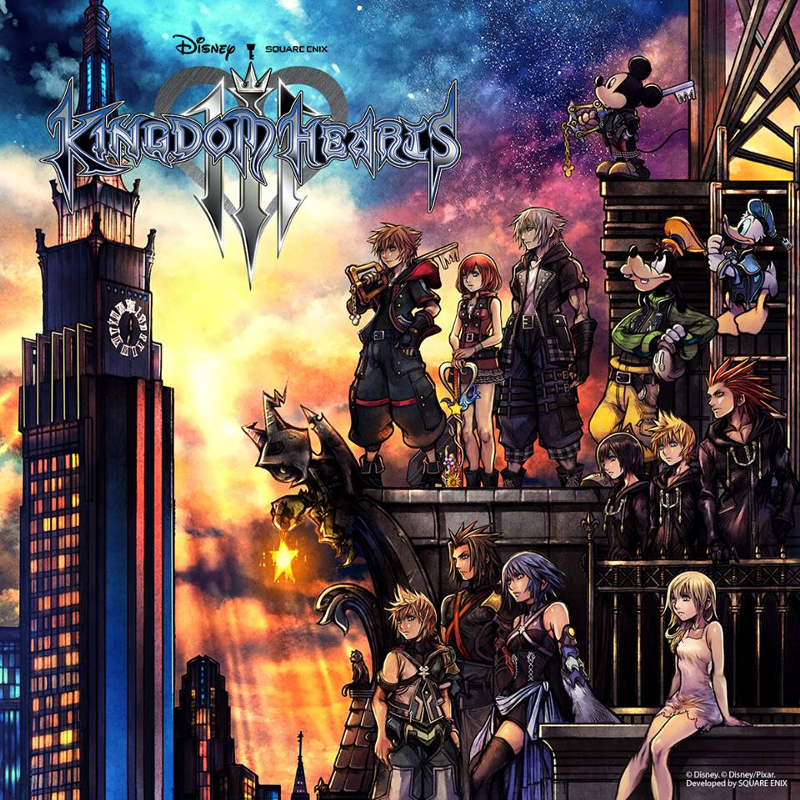
Written by Brandon C. Kesselly (@bckesso)
Kingdom Hearts (KH) is one of the weirdest franchises to explain. A marriage of Disney properties and Final Fantasy games, KH tells the story of Sora, a boy on a journey across the universe battling evil with a gigantic skeleton key known as the Keyblade. Together with his childhood friends Riku and Kairi, as well as Donald Duck, Goofy, and King Mickey Mouse, Sora is tasked with defeating the likes of Organization XIII and their merciless hordes of Heartless, Nobodies, and now, Unversed.
Due to its roots, the series has always boasted a slew of epic boss battles and cinematic music. You’re just as likely to have fun fighting Aladdin’s Jafar or Sleeping Beauty’s Maleficent, as you are fighting Final Fantasy VII’s Cloud Strife or Sephiroth or Final Fantasy VIII’s Squall Leonheart (AKA “Leon”).
But, most of all, it’s fun because of the combat options. And they have a lot.
Each installment has added some new element while improving upon the old. Kingdom Hearts III looks to marry the mechanics of the handheld games with those of their console counterparts for the first time. This may seem daunting or overly-complicated for newcomers, but I’m here to tell you just how flexible it is.
Now, let’s start with the basics.
Party
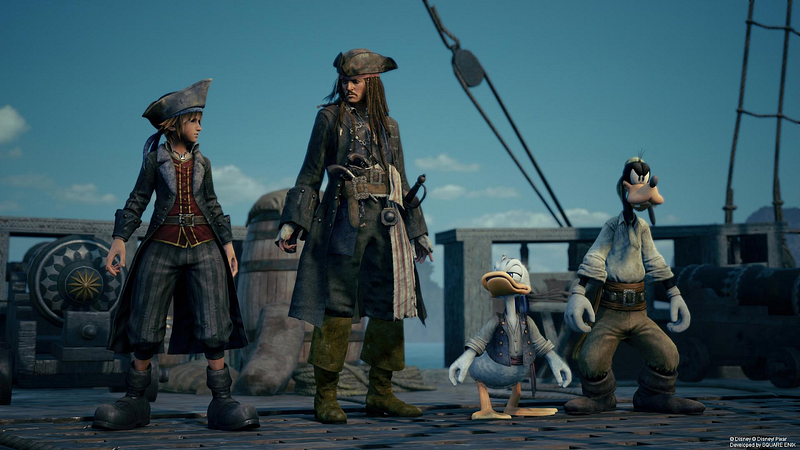
As with its sibling series Final Fantasy, Kingdom Hearts has always had non-playable characters (NPCs) aid Sora in combat. While Donald and Goofy form your main party, you are also joined by other characters from Disney and Final Fantasy, as well as original Kingdom Hearts characters.
KHIII continues this trend, allowing for parties of up to five characters at once. In order to prevent too much crossover, party members are world-specific. For example, Hercules can only join your party in Olympus Coliseum, while Woody Pride and Buzz Lightyear can only aid you in Toy Box, and Baymax only in San Fransokyo.
Party members have their own combat abilities, as well as combo attacks with Sora. They can also be equipped with items to help out in a pinch.
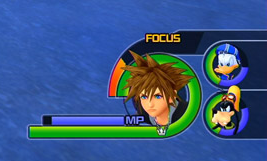
The bottom right hand corner of the screen also displays your party status gauges. This includes your hit points (HP), magic points (MP), and Focus meter, as well as your party members’ HP and MP.
HP is the amount of damage characters can take before being defeated. The goal is to deplete your enemies’ HP before they can do the same to you. If party members are defeated, they are temporarily KO’d and will revive when healed, post-combat, or after enough time passes. If Sora is defeated, it is Game Over.
MP manages how many spells or special attacks characters can use in combat. The more MP available, the more spells and/or attacks at your disposal. When MP is depleted, characters enter a cooldown period (“MP Charge”) and the gauge is unavailable for a short time period.
The Focus meter manages Shotlocks. More on that later!
Command Menu
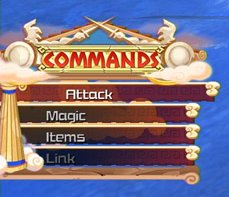
While it all takes place in real time, KH combat is menu-based. Players use the directional buttons to maneuver the Command menu and click the X button to execute commands (for Playstation; A button for Xbox). The Command menu is located in the lower left-hand corner of the screen.
Some of the options have varied over time, but the menu for KHIII contains the following commands: Attack, Magic, Items, and Link. There is also a Shortcuts menu to map your favorite spells, items, and summons to hotkeys. This menu is accessible using L1 (on Playstation; LB on Xbox). KHIII adds three shortcut menus that can be cycled using the arrow buttons.
Attack
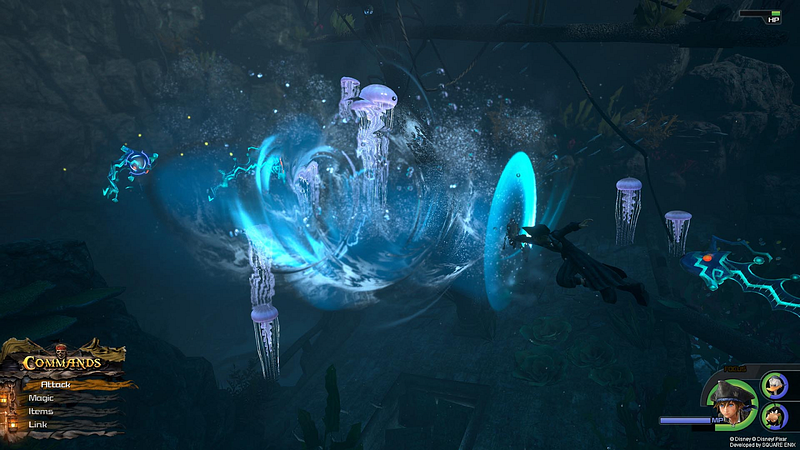
The Attack command uses the Keyblade or other equipped weapon to deal physical damage to enemies. Repeated use of this command results in combinations. Sora can attack both on the ground and in the air, resulting in different combos in each scenario. When Sora has reached the end of his combo, he will perform a combo finisher, which deals heavy damage to enemies. Combos can be extended with the Combo Plus ability.
Magic
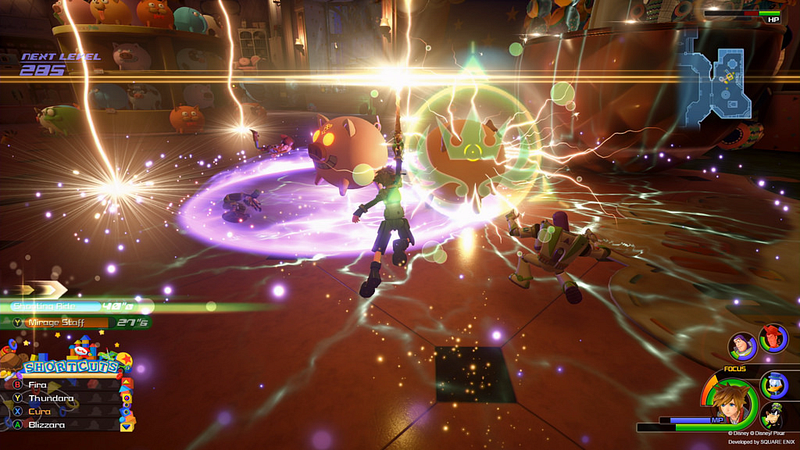
The Magic command allows Sora to cast spells. Offensive spells like Fire, Blizzard, and Thunder can be used to deal elemental damage to foes, while defensive ones like Cure or Reflect can recover HP and repel attacks, respectively. Defensive spells can be cast on Sora or other party members. Spells can also level up, with tiers two and three ending in -ra, and -ga, respectively. (e.g. Fire → Fira → Firaga). A fourth tier, -za, is accessible as a Grand Magic Situation Command.
As previously mentioned, Magic is managed by MP, with each spell costing a certain amount. Powerful spells cost more MP. When a character has zero MP, they enter “MP Charge” mode and cannot cast spells until the gauge refills. MP Charge time can be decreased with the MP Haste ability.
Similar to basic attacks, spells can also be stacked in combinations. You can mix spells together in unique combos, continuously spam the same spell, or fuse them with basic attacks. Stacking magic attacks ends in a magic finisher, and magic combos last the same length as attack combos. These are also extended with Combo Plus.
Items
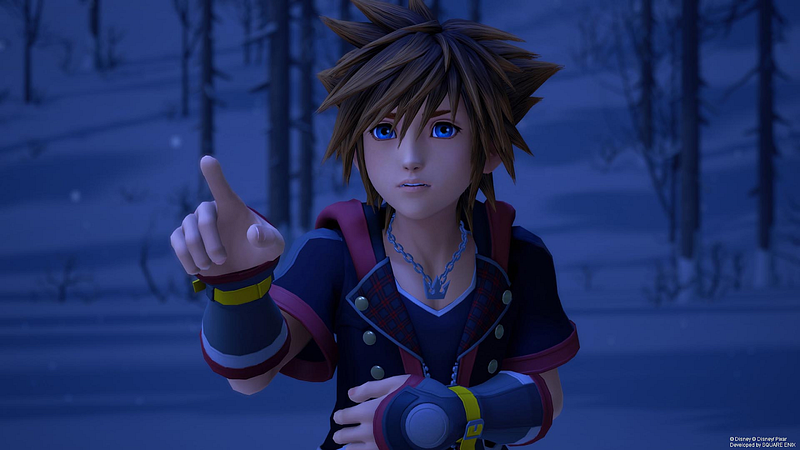
Items are crucial to every good RPG. When you or your party members are low on HP or MP, you’ll want to be sure to have the right items available to quickly recover. Potions, for example, recover HP, while Ethers recover MP. Elixirs recover both. Some items, like Mega-Potions and Mega-Ethers, can be used for the entire party. Other items can only be used outside of combat.
Characters have a finite amount of items they can carry in combat. Similar items can occupy the same slot, but characters are limited by their available slots. If you have three slots, for example, you can carry the maximum number each of Potions, Ethers, and Elixirs, but will not have room for Hi-Potions or Megalixirs.
Equipped items automatically refill after combat, based on availability. Items can also be added to the Shortcuts menu.
Link
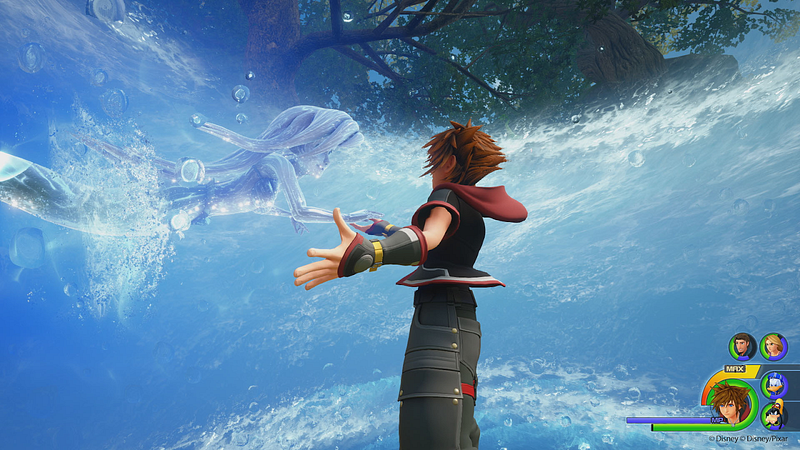
Formerly known as “Summon”, the Link command calls forth creatures and characters from other worlds to aid in combat for a short period of time.
Summons have typically been Disney characters such as Genie (Aladdin), Mushu (Mulan), and Tinker Bell (Peter Pan). For KHIII, Ariel (The Little Mermaid), Simba (The Lion King), Ralph (Wreck-It Ralph), and Stitch (Lilo & Stitch) are all Link summons. Meow Wow, a Dream Eater from Kingdom Hearts 3D: Dream Drop Distance, is also a Link summon.
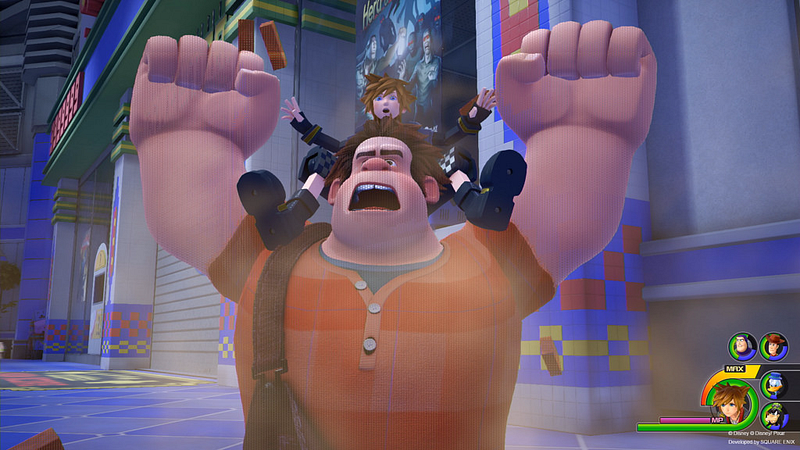
Links are managed by the MP gauge, meaning they consume all of your magic points and force Sora into MP Charge. As a result, Links fully recover your party’s HP, but also require full MP to use. They can be voluntarily dismissed from the battlefield, and each come with their own Command menu, allowing you to utilize their unique abilities in combat until their dismissal.
Links are typically recommended for crowd control or to use abilities that can’t be replicated by spells or party members.
Situation Commands
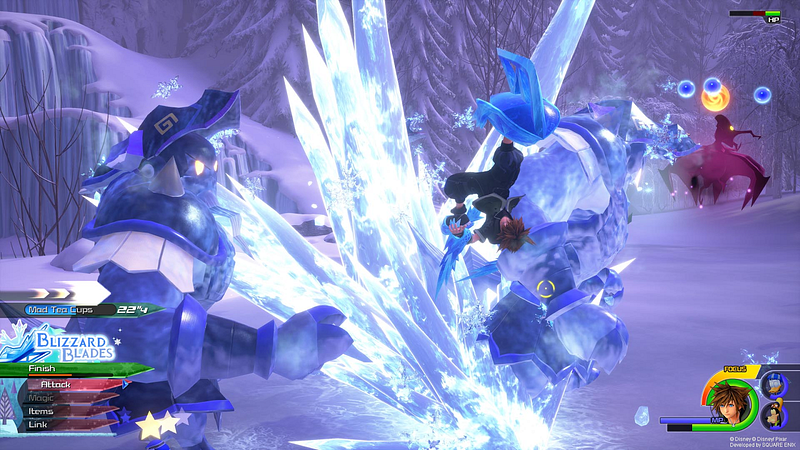
Formerly referred to as “Reaction Commands” in Kingdom Hearts II, Situation Commands are a mechanic that was introduced in Kingdom Hearts 0.2: Final Chapter Prologue (I know, the names the get weird; just roll with it). Situation Commands are triggered when certain conditions are met, such as physical or magic combos, or finding a treasure chest.
When when certain criteria are met, Situation Commands appear above the Command menu. When a Command is available, it is activated by pressing the Triangle button (on PS4; Y button on Xbox). When multiple Commands are available, you can cycle through them by pressing L2 (on PS4; LT on Xbox) and pressing Triangle (Y on Xbox). Be mindful: in combat, these commands have a time limit before they disappear.
On top of the aforementioned Grand Magic, Situation Commands are also used to trigger Formchanges, Attractions,and Team Attacks.
Formchanges

Originally introduced as “Drive Forms” in Kingdom Hearts II, Forms are transformations that enhance Sora’s combat abilities for a short period of time. Depending on the Form, his available commands and combos are usually affected, as well as his stats.

Unlike in KHII, where Forms used party members as resources, KHIII manages Forms through Keyblade formchanges, which are initiated using Situation Commands. Forms are also Keyblade-specific, meaning that equipping certain weapons grants access to specific forms. Sora can equip up to three Keyblades at once, and switch between them in combat on the fly.
Formchanges modify Sora’s appearance and combat style, such as Second Form and Rage Form. Others, such as Hyper Hammer and Double Arrowguns, also change the Keyblade into different weapons entirely.
Attractions
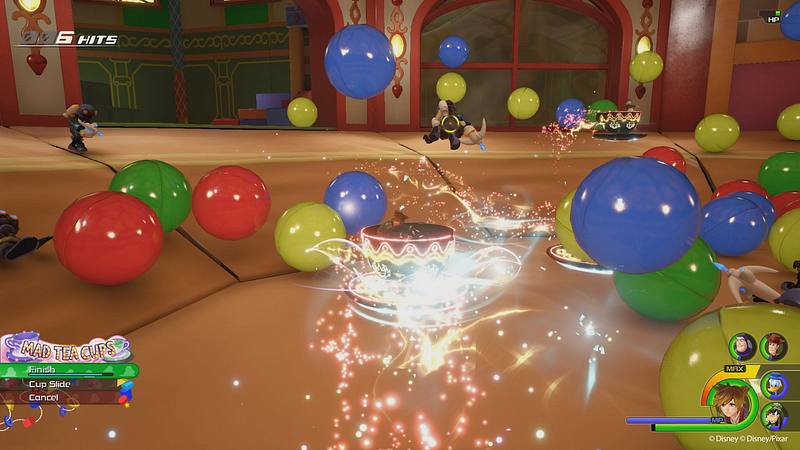
Making its debut in KHIII, Attraction Flow is a new mechanic inspired by Disney theme park rides. Using a corresponding Situation Command, Sora can summon an Attraction to the battlefield for a short period of time, performing a variety of attacks.
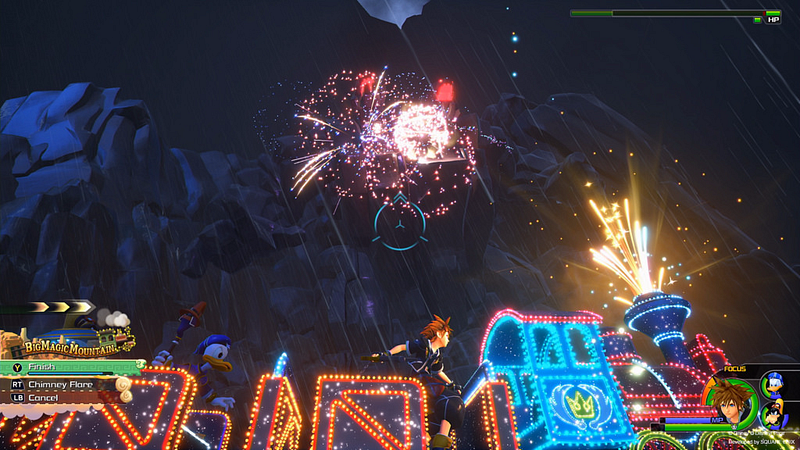
Unlike Magic or Finish commands, Attractions are either world- or enemy-specific, meaning they are tied to events rather than stacking commands. For example, Big Magic Mountain (based on Splash Mountain) is only available during the (Rock) Titan boss fight on Olympus Coliseum. Attractions also do not require MP to use, but are time-limited like other Situation Commands.
Shotlocks
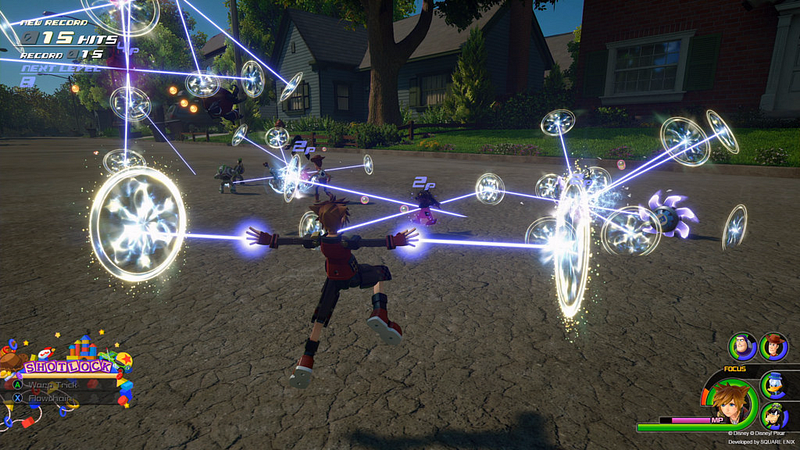
Originally introduced in Kingdom Hearts: Birth By Sleep, Shotlocks are attacks that deal damage to targeted enemies. Similar to Formchanges, Shotlocks are Keyblade-specific, and will change depending on the equipped weapon.
Shotlocks are managed by the Focus gauge, and are triggered by the lock-on button (R1 on PS4, RT on Xbox One).
Team Attacks
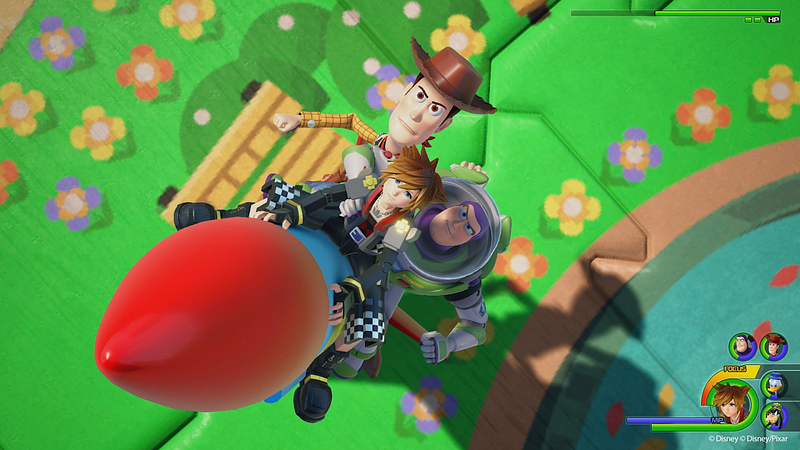
Previously referred to as “Limits” in Kingdom Hearts II, Team Attacks are combination attacks between Sora and his party members. They are triggered as Situation Commands, and are dependent upon the party members involved.
Sora can initiate a Team Attack with Donald, Goofy, or both, as well as world-specific party members like Woody and Buzz from Toy Box or Rapunzel and Flynn Rider from the Kingdom of Corona. Similar to attractions, team attacks do not require MP or Focus to use, but are time-limited.
Kingdom Hearts III was released on Playstation 4 and Xbox One January 25, 2019 in Japan and January 29 worldwide.
Want to keep up with The RYM? Like us on Facebook, follow us on Twitter, follow us on Instagram, or join our mailing list below!



